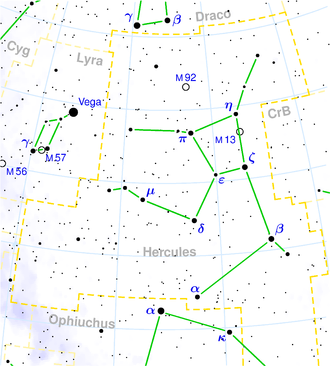NGC 6276
| Galaxy NGC 6276 |
|
|---|---|
![NGC 6276 with NGC 6278 (u) [1] SDSS image](https://upload.wikimedia.org/wikipedia/commons/thumb/1/1f/NGC6276_-_SDSS_DR14.jpg/300px-NGC6276_-_SDSS_DR14.jpg)
|
|
| NGC 6276 with NGC 6278 (u) SDSS image | |
| AladinLite | |
| Constellation | Hercules |
|
Position equinox : J2000.0 , epoch : J2000.0 |
|
| Right ascension | 17 h 00 m 45.087 s |
| declination | + 23 ° 02 ′ 38.36 ″ |
| Appearance | |
| Morphological type | S0 |
| Brightness (visual) | 14.6 mag |
| Brightness (B-band) | 15.6 mag |
| Angular expansion | 0.4 ′ × 0.3 ′ |
| Position angle | 123 ° |
| Surface brightness | 12.2 mag / arcmin² |
| Physical data | |
| Affiliation | WBL 629 |
| Redshift | 0.009186 ± 0.000073 |
| Radial velocity | 2754 ± 22 km / s |
|
Stroke distance v rad / H 0 |
(129 ± 9) · 10 6 ly (39.7 ± 2.8) Mpc |
| history | |
| discovery | Albert Marth |
| Discovery date | June 10, 1864 |
| Catalog names | |
| NGC 6276 • IC 1239 • PGC 59419 • CGCG 139.28 • MCG + 04-40-010 • 2MASX J17004498 + 2302384 • GC 5842 • GALEX ASC J170045.08 + 230239.1 • NSA 69842 • WISEA J170045.07 + 230238.6 • HOLM 765B | |
NGC 6276 = IC 1239 is a 14.6 likes bright lenticular dwarf galaxy from the Hubble type S0 in the constellation Hercules at the northern sky . It is an estimated 129 million light-years from the Milky Way and about 15,000 light-years across. Together with NGC 6278 , it forms the gravitationally bound galaxy pair Holm 765 .
In the same area of the sky are u. a. the galaxies NGC 6267 and IC 4639 .
The object was discovered by Albert Marth on June 10, 1864 . The objects NGC 6276 , NGC 6277 and NGC 6278 located in this area were noted by different astronomers with different position errors. Dreyer was unable to resolve these discrepancies when creating the catalog, so that Guillaume Bigourdan's observation on June 19, 1887, received an entry in the index catalog under IC 1239 .
Web links
- NGC 6276. SIMBAD , accessed July 19, 2016 .
- NGC 6276. DSO Browser, accessed July 19, 2016 .
- Auke Slotegraaf : NGC 6276. Deep Sky Observer's Companion, accessed on July 19, 2016 (English).
